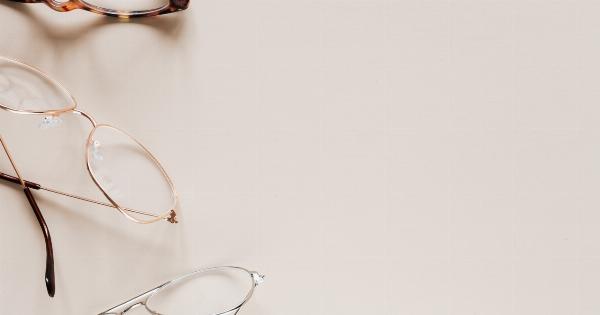Squinting is a natural instinct that humans and many animals use to improve their visual clarity. It involves narrowing the eyes to reduce the amount of light entering the eyes and to focus on a specific object or scene.
While squinting may seem like a simple action, there is actually a scientific explanation behind its effectiveness. In this article, we will explore the science behind squinting and how it can lead to better visual clarity.
How Squinting Works
When we squint, we partially close our eyelids, causing the size of the pupils to decrease. The smaller the pupil, the less light enters the eye.
This reduction in light helps to prevent the scattering of light rays that can cause blurred vision and reduces glare. By narrowing the eyes, we create a pinhole effect, which increases the depth of field and enhances our ability to focus on objects both near and far.
Moreover, squinting changes the shape and curvature of the cornea and lens in our eyes, which can improve the focusing of light onto the retina.
By altering the way light is refracted, squinting compensates for certain refractive errors, such as nearsightedness or farsightedness, resulting in clearer vision.
The Role of Tears
Our eyes produce tears, which play a critical role in maintaining visual clarity. Tears are not only responsible for keeping our eyes lubricated and comfortable, but they also help in the process of squinting.
When we squint, tears spread across the surface of the eyes, creating a smooth and even surface. This smooth surface allows light to enter the eye without distortion and further enhances visual acuity.
The tear film that covers the front of the eyes also acts as an optical element, similar to a camera lens. It helps to focus light onto the retina and improves the quality of the images formed on the retina.
Without tears, squinting would be less effective in improving visual clarity.
Squinting and Near-Point Stress
Squinting not only aids in focusing on distant objects but also plays a role in reducing near-point stress, also known as accommodative stress.
Near-point stress occurs when we constantly focus on nearby objects for extended periods, such as reading or using digital devices. This can cause eye strain, blurred vision, and fatigue.
When we squint while reading or performing close-up tasks, we reduce the size of the pupils, allowing for less light to enter the eyes.
By reducing the amount of light reaching the eyes, squinting helps to relax the focusing muscles in the eyes that are responsible for near-point stress. This restorative effect can alleviate eye strain and improve visual comfort during near tasks.
The Benefits of Squinting
Squinting is more than just a reflex action; it offers several benefits for our vision:.
- Improved Visual Acuity: Squinting helps to sharpen our focus and enhances our ability to discern fine details, improving overall visual acuity.
- Glare Reduction: By reducing the amount of light entering the eyes, squinting reduces glare and enhances our ability to see in bright sunlight or when facing direct light sources.
- Better Depth Perception: The pinhole effect created by squinting increases the depth of field, allowing us to perceive depth and judge distances more accurately.
- Enhanced Color Perception: Squinting can also enhance our perception of colors, as reducing glare and improving contrast makes colors appear more vibrant and distinct.
- Temporary Vision Correction: Squinting can compensate for certain refractive errors and temporarily improve vision without the need for corrective lenses.
- Eyestrain Relief: Squinting can provide temporary relief from eyestrain, particularly during prolonged near work or when exposed to bright lights.
When Squinting Isn’t Enough
While squinting can be beneficial in certain situations, it is important to note that it is not a substitute for proper vision correction or eye care.
Squinting may help temporarily improve vision, but it does not address underlying vision problems or refractive errors.
If you find yourself squinting frequently or relying on it to see clearly, it is recommended to schedule an eye examination with an optometrist or ophthalmologist.
A comprehensive eye exam can help identify any vision issues and determine the most suitable vision correction options, such as glasses or contact lenses.
Tips for Healthy Vision
In addition to understanding the science behind squinting, there are several other strategies you can follow to maintain good eye health and maximize visual clarity:.
- Regular Eye Exams: Schedule comprehensive eye exams to monitor your eye health, detect any vision problems, and ensure optimal visual clarity.
- Wear Proper Eyewear: If prescribed, wear corrective lenses such as glasses or contact lenses to address refractive errors and improve overall visual acuity.
- Take Breaks from Near Work: When engaged in tasks that require prolonged focus, such as reading or using digital devices, take frequent breaks to reduce eye strain and fatigue.
- Adjust Lighting Conditions: Ensure adequate and appropriate lighting while working or reading to minimize eye strain and optimize visual comfort.
- Follow the 20-20-20 Rule: To prevent eye fatigue during prolonged screen time, look away from your screen every 20 minutes and focus on an object at least 20 feet away for at least 20 seconds.
- Maintain a Healthy Lifestyle: Eat a balanced diet rich in eye-nourishing nutrients, stay hydrated, get regular exercise, and protect your eyes from harmful UV rays by wearing sunglasses outdoors.
By adopting these practices and understanding the science behind squinting, you can optimize your visual clarity and maintain healthy eyes for years to come.



























